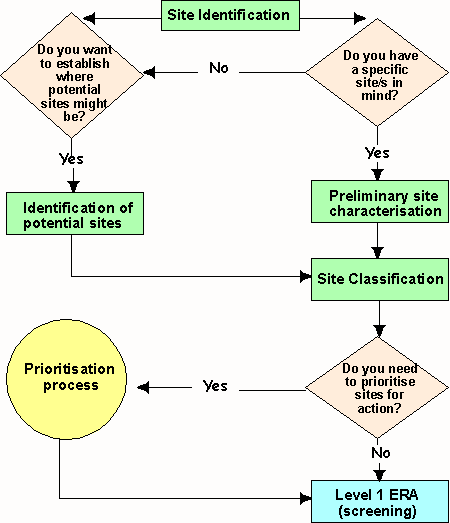|
Limitations of risk assessment Description
|
Identification of Potential SitesThe objective of this task is to identify a site and determine if it is likely to require further study. The following information sources are useful to help identify potentially contaminated sites:
At this stage no assumptions have been made about the need to conduct an RA or decide any actions for a site, but will inform the next stage of preliminary site characterisation. Preliminary Site CharacterisationThe objective of a preliminary site characterisation is to determine two main points:
In order to do this, you should record the following basic information about each individual site of concern:
Each site should be mapped in relation to its surroundings and potential contaminants of concern. Several useful information sources can help in this task: Information obtained from the preliminary site characterisation will not usually be sufficient to decide any course of action for the site, unless, for example, the information shows conclusively that potential contaminants were never used at a site. Site ClassificationSite classification is simply a method of categorising sites based on the information you have collected about the potential for contamination and the possible ecological values present. The three basic classifications are:
The three basic categories for human receptors and ecological values are:
You may need to undertake an issues-identification exercise to determine which specific ecological values are important, (e.g., wetlands, rivers, indigenous vegetation, reserves). Likewise you may need to determine whether people resident or working in the area might be exposed to contaminants. The result will be a matrix to highlight the sites of most concern:
You may decide that other categories are appropriate as a means of dividing the sites into groups. However, at this stage the purpose of site classification is simply to assist with the next step of prioritising the sites.
PrioritisationA site manager may be dealing with more than one potentially contaminated site, in which case, some form of prioritisation based on the site classification step above may be necessary. This is to ensure that resources for further site investigation are focused on those sites with the greatest potential risk. There are several methods available to prioritise sites. Many regulatory authorities in New Zealand use the Rapid Hazard Assessment System (RHAS), which is predominantly human-health based. This method as been updated by the Classification and Information Management Protocols prepared for The Ministry for the Environment in 2001. The method you use to prioritise the sites for an ERA should provide an outcome appropriate for the circumstances, for example, taking into account financial and resourcing constraints. Once a site has been identified as requiring an assessment, the RA framework process should then be followed.
This diagram shows how the above steps are used:
|
![]()
